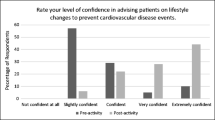Abstract
To assess the difference of pre- and post-training performance evaluation of continuing medical education (CME) courses in cardio-vascular diseases (CVD) management among physicians at primary health care facilities of Armenian regions we conducted an evaluation survey. 212 medical records were surveyed on assessment of performance before and after the training courses through a self-employed structured questionnaire. Analysis of survey revealed statistically significant differences (p < 0.05) in a number of variables: threefold increased recording of lipids and body mass index (p = 0.001); moderate increased recording of comorbidities and aspirin prescription (p < 0.012); eightfold increased recording of dyslipidemia management plan, twofold increased recording for CVD management plan and fivefold increased recording for CVD absolute risk (p = 0.000). Missing records of electrocardiography and urine/creatinine analyses decreased statistically significantly (p < 0.05). Statistically significant decrease was observed in prescription of thiazides and angiotensin receptor blockers/angiotensin converting enzyme inhibitors (p < 0.005), while prescription of statins and statins with diet for dyslipidemia management showed increased recording (p < 0.05). Similarly, we observed increased records for counseling of rehabilitation physical activity (p = 0.006). In this survey most differences in pre- and post-evaluation of performance assessment may be explained by improved and interactive training modes, more advanced methods of demonstration of modeling. Current findings may serve a basis for future planning of CME courses for physicians of remote areas facing challenges in upgrading their knowledge, as well as expand the experience of performance assessment along with evaluation of knowledge scores.
Similar content being viewed by others
References
Peck, C., McCall, M., McLaren, B., & Rotem, T. (2000). Continuing medical education and continuing professional development: International comparisons. British Medical Journal, 320(7232), 432–435.
Cantillon, P., & Jones, R. (1999). Does continuing medical education in general practice make a difference? British Medical Journal, 318(7193), 1276–1279.
Marinopoulos, S. S., Dorman, T., Ratanawongsa, N., Wilson, L. M., Ashar, B. H., Magaziner, J. L., et al. (2007). Effectiveness of continuing medical education. Evidence report/Technology assessment, 149, 1–69.
Bennett, N. L., Davis, D. A., Easterling, W. E., Friedmann, P., Green, J. S., Koeppen, B. M., et al. (2000). Continuing medical education: A new vision of the professional development of physicians. Academic Medicine, 75(12), 1167–1172.
Davis, D. A., O’Brien, A. T., Freemantle, N., Wolf, F. M., Mazmanian, P., & Taylor-Vaisey, A. (1999). Impact of formal continuing medical education. JAMA, the Journal of the American Medical Association, 282(9), 867–874.
White, C. W., Albanese, M. A., Brown, D. D., & Caplan, R. M. (1985). The effectiveness of continuing medical education in changing the behavior of physicians caring for patients with acute myocardial infarction: A controlled randomized trial. Annals of Internal Medicine, 102(5), 686–692.
Grimshaw, J. M., & Russell, I. T. (1993). Effect on clinical guidelines on medical practice: A systematic review of rigorous evaluations. The Lancet, 342(8883), 1317–1322.
Smits, P. B., Verbeek, J. H., & de Buisonje, C. D. (2002). Problem based learning in continuing medical education: A review of controlled evaluation studies. BMJ, 324, 153.
Tian, J., Atkinson, N. L., Portnoy, B., & Gold, B. S. (2007). A systematic review of evaluation in formal continuing medical education. Journal of Continuing Education in the Health Professionals, 27(1), 16–27.
Mansouri, M., & Lockyer, J. (2007). A meta-analysis of continuing medical education effectiveness. Journal of Continuing Education in the Health Professionals, 27(1), 6–15.
Davis, D. A., Thomson, M. A., Oxman, A. D., & Haynes, R. B. (1995). Changing physician performance: A systematic review of the effect of continuing medical education strategies. JAMA, 274(9), 700–705.
Goldstein, M. K., Lavori, P., Coleman, R., Adyani, A., & Hoffman, B. B. (2005). Improving adherence to guidelines for hypertension drug prescribing: Cluster-randomized controlled trial of general versus patient-specific recommendations. The American Journal of Managed Care, 11(11), 677–685.
Kutcher, S. P., Lauria-Horner, B. A., MacLaren, C. M., & Bujas-Bobanovic, M. (2002). Evaluating the impact of an educational program on practice patterns of Canadian family physicians interested in depression treatment. Primary Care Companion to the Journal of Clinical Psychiatry, 4(6), 224–231.
Zuckerman, I. H., Weiss, S. R., McNally, D., Layne, B., Mullins, C. D., & Wang, J. (2004). Impact of an educational intervention for secondary prevention of myocardial infarction on Medicaid drug use and cost. The American Journal of Managed Care, 10, 493–500.
Gullion, D. S., Adamson, T. E., & Watts, M. S. (1983). The effect of individualized practice-based CME program on physician performance and patient outcomes. Western Journal of Medicine, 138(4), 582–588.
Bloom, B. S. (2005). Effects of continuing medical education on improving physician clinical care and patient health: A review of systematic reviews. International Journal of Technology Assessment in Health Care, 21(03), 380–385.
Allaire, B. T., Trogdon, J. G., Egan, B. M., Lackland, D. T., & Masters, D. (2011). Measuring the impact of a continuing medical education program on patient blood pressure. The Journal of Clinical Hypertension, 13(7), 517–522.
Trogdon, J. G., Allaire, B. T., Egan, B. M., Lackland, D. T., & Masters, D. (2011). Training providers in hypertension guidelines: Cost-effectiveness evaluation of a continuing medical education program in South Carolina. American Heart Journal, 162(4), 786–793.
Gerstein, H. C., Reddy, S. S., Dawson, K. G., Yale, J. F., Shannon, S., & Norman, G. (1999). A controlled evaluation of a national continuing medical education programme designed to improve family physicians’ implementation of diabetes-specific clinical practice guidelines. Diabetic Medicine, 16(11), 964–969.
Author information
Authors and Affiliations
Corresponding author
Rights and permissions
About this article
Cite this article
Khachatryan, L., Balalian, A. Performance Assessment Through Pre- and Post-training Evaluation of Continuing Medical Education Courses in Prevention and Management of Cardio-Vascular Diseases in Primary Health Care Facilities of Armenia. J Community Health 38, 1132–1139 (2013). https://doi.org/10.1007/s10900-013-9724-7
Published:
Issue Date:
DOI: https://doi.org/10.1007/s10900-013-9724-7




